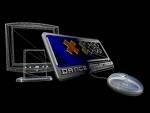
Most of us often wish that some of our extra pounds could just melt away, and now it seems scientists have a solution, an X-ray machine that melts away fat is on the anvil. Although it sounds too good to be true, doctors are predicting that one day weight loss could be achieved with the wave of a laser wand.
You simply walk through an airport-style X-ray scanner which would “fry” excess fatty tissue. Three days later and five pounds would have melted away through the body’s normal purging processes.
Repeat the procedure every two weeks until you’ve reached your target weight - no dieting required. The only downside will be resizing your wardrobe, according to a review of emerging technologies published today in the British Medical Journal.
It is just one of the forecasts made by Professor Donald Combs of the Eastern Virginia Medical School, USA, that are set to transform medicine.
Among the others are “smart” nappies that can detect common childhood infections and miniature telescopes to restore vision.
He says the “startling” advances on the horizon include tiny implants that will monitor the medication needs of patients with chronic diseases. Eventually they will be linked with smart pumps implanted in the body that, when signalled, instantly deliver the correct medication.
These innovations are the inevitable outcome of technologies currently under development, he says. Devices that can sense and transmit heart and breathing rates already exist, for example the LifeShirt which is a non-invasive, continuous monitoring system woven into a shirt that collects data on lung, cardiac and other vital signs.
Prof Combs said the five key technologies for future advances are molecular medicine and biometrics, nanotechnology, wave technology, fabricators - such as biological bandages - and robotics.
He said “These technologies already have had individual and collective effects on some aspects of medicine and their influence is increasing.”
Recent discoveries on wave technology have shown that laser pulses of certain types of light wave destroy fat but do not harm other types of cells, he said.
It is also becoming possible to analyse data on a single drop of blood, urine or faeces to detect harmful bugs ranging from anthrax to influenza.
“The spread of infectious diseases would be dramatically reduced if people could be diagnosed, isolated and treated before becoming symptomatic. “For example, imagine the impact on the incidence of disease in a group of sailors if they were tested the day before their deployment on a ship’ said Prof Combs. A more visible daily application would be a smart nappy programmed to change colour when common childhood bugs are detected in urine or faeces, he added.
Another prediction is the use of miniature telescopes that restore vision for patients with degenerative eye disease. The telescopes are powered by sunlight passing through the pupils to microscopic solar battery panels attached to the retinas.
After several years the telescopes and batteries are removed and replaced with a genetic patch that turns off the overproduction of blood vessels causing the problem, and restores her normal vision.
In another scenario, Prof Combs predicts that Jane, who has high blood pressure and diabetes, has a barely visible radio frequency chip implanted just below the skin on her upper arm.
This chip simultaneously monitors and transmits data on her heart rate, respiratory rate, blood pressure and concentrations of blood sugar.
The data is transmitted to her GP’s surgery and to an implanted pump linked to her circulatory system and to an external reservoir of drugs that can be tapped into when necessary.
Tailor-made robotic parts could be manufactured for patients needing knee and hip replacements, for example, which are then implanted into the body.
Prof Combs says the predictions come from “30 years in health care and academic medicine” with all having the potential to “change medicine in startling ways.






















































